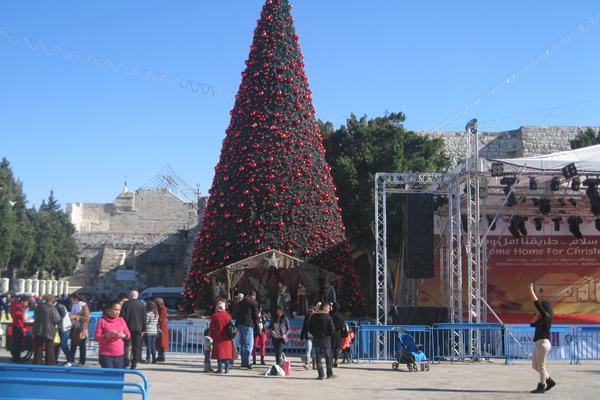In what some are calling the biggest miracle in Bethlehem since the birth of Jesus, the three churches that share responsibility for the Nativity church put aside centuries of tense relations this past year to ensure the job gets done.
In an act of diplomatic prowess, the Palestinian Authority persuaded the Latin (Roman Catholic), Greek Orthodox and Apostolic Armenian churches to sign an agreement permitting the restoration of the church, whose basilica was built by the Byzantine Emperor Justinian about 600 C.E. by the Roman Emperor Constantine, was mostly destroyed 200 years later. The existing church was built on the same site.
Rainwater has been damaging the church’s infrastructure and artwork for more than a century, but infighting over which church has authority prevented a resolution.
The repairs, being carried out by an Italian restoration company, will cost about $2.6 million. Various governments and donors will foot the bill. But “money was never the main problem,” Pizzaballa insisted.
“The problem was taking personal responsibility,” he said.
The Palestinian Authority launched efforts to bring the churches together after it persuaded UNESCO, the cultural wing of the United Nations, to designate it an “endangered” world heritage site in 2012. The designation is intended for sites that are in imminent danger of collapse.
Israel, which captured the West Bank in the 1967 Middle East war, said UNESCO used the designation to strengthen Palestinian claims over the disputed territory. The Nativity church is the first site under Palestinian control to receive heritage status.
Politics aside, no one disputes that the basilica is in a sorry state. Inside the stone church, the towering walls and 18-foot high columns are discolored and peeling, and the windows let in rain and cold air.
But the most pressing problem is the roof, said the Rev. Peter Vasko, president of the Franciscan Foundation for the Holy Land, a church agency that provides scholarships, subsidized housing and jobs to Christians.
Standing just outside the church where busloads of Christians and some Muslims were waiting patiently for their turn to enter the basilica the Sunday before Christmas, Vasko said, “Leaks have weakened the roof, and we are taking precautions to prevent it from toppling on pilgrims.”
Despite the scaffolding, the church itself was packed with thousands of faithful from dozens of countries. Hundreds of other visitors posed for photos in front of a giant Christmas tree and nativity scene erected in adjoining Manger Square.
David Nour, a Palestinian Christian who had brought his wife and two daughters to Bethlehem from nearby Beit Sahour, said the repairs “are very important because this is our legacy to our children.”
While Nour lauded the monumental efforts to salvage the church, he said that without jobs and the ability to traverse Israeli checkpoints, the tiny community of West Bank Christians — whose numbers have been decimated by emigration over the decades — will eventually disappear, leaving only the churches.
“Bethlehem is a small place, and without the ability to get to enter Jerusalem without a special permit, or to travel freely within the West Bank, business suffers,” said Nour, who owns a design and printing company.
“Repairing the church is important but improving our living conditions is even more important,” he said.
Still, as Christmas approaches, the first baby steps provided a sign of hope.
The effort to restore the church has helped “unblock the complicated relations” that have existed between the various churches for centuries, said Pizzaballa, the Catholic Church’s custodian of the Holy Land.
“We were each into our own way of doing things,” he said. “This forced us to find a solution together.”
Michele Chabin writes for Religion News Service. Via RNS.
Got something to say about what you're reading? We value your feedback!
